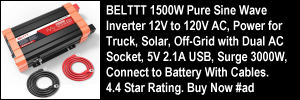Professional driver Mike Simons has used a “Tornado Fan” and a metal fan — both made by RoadPro® and both purchased in a truck stop — in his truck.
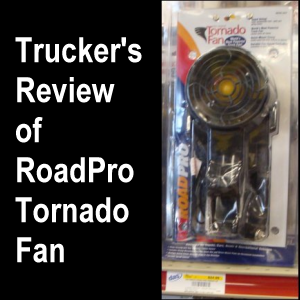 On this page, he reviews the former, providing the pros and cons of using this unit.
On this page, he reviews the former, providing the pros and cons of using this unit.
What Prompted the Purchase
Around August 2007, the air conditioning went out in the company truck (a Freightliner Columbia) that Mike drove for his at-that-time regional trucking company.
Because it was the end of the summer, it was quite warm.
After using the metal fan for some time, he ended up replacing it with another fan by RoadPro®, a “Tornado Fan”, shown here.
He kept the unit in his truck through the time that Vicki began riding with him in 2009.
Unlike the metal fan, this unit was constructed mostly of hard plastic.
Mike lists the pros and cons of the RoadPro® 12-volt fan that he bought as follows:
Pros of the Tornado Fan
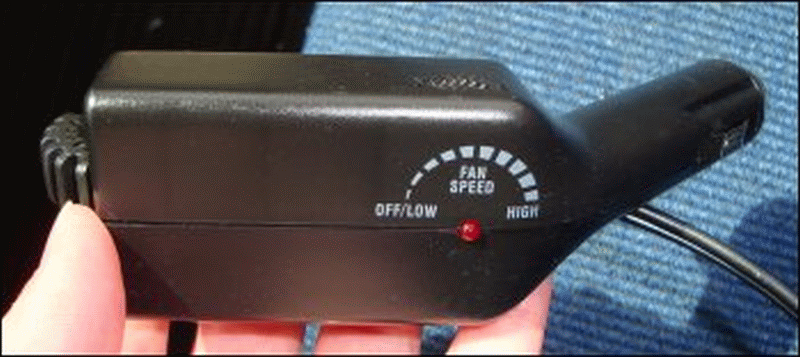 It had a dial-type switch to allow the user to set the speed of the blades.
It had a dial-type switch to allow the user to set the speed of the blades.
When “on” all the way, it really moved the air (as you would expect anything labeled “tornado” to do).
The unit could be positioned to direct air where needed, even toward the top bunk.
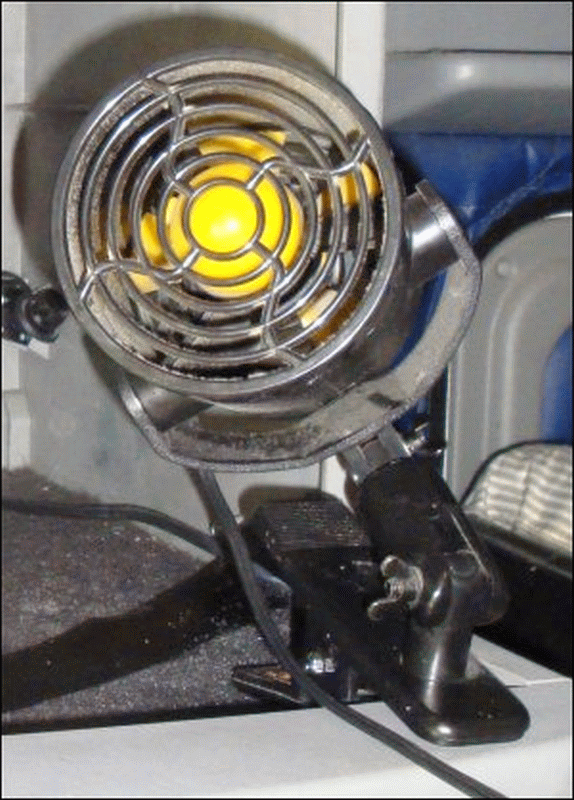 The device had a very strong clamp, which could be attached to the edge of a built-in cabinet in the sleeper area.
The device had a very strong clamp, which could be attached to the edge of a built-in cabinet in the sleeper area.
This feature made it possible for the unit to be used while the truck was in motion.
 It could be plugged directly into a 12-volt outlet.
It could be plugged directly into a 12-volt outlet.
Many trucks manufactured today (at least many Freightliners) have a 12-volt outlet built into the cabinet where a small television can be placed (as shown here).
Also, the unit was designed in a compact size.
Cons of the Tornado Fan
This unit was extremely noisy.
Vicki is sensitive to unnecessary noise and she says that the Tornado Fan was the noisiest fan for its size that she’d ever heard.
The noise may have been compounded by the fact that the space inside the truck is fairly small when compared to a room in your house.
Just to be able to sleep, when Vicki rode with Mike and the truck was turned off for the night and the Tornado Fan was turned on, Vicki had to wear ear plugs in her ears — like the ones shown here from Amazon.com, with which we have an affiliate relationship.
The Tornado Fan was expensive when compared to some small 120-volt (household) fans.
At the time this page was written, the cost of the unit shown in the photo (taken at a Pilot truckstop) was $24.99.
We have seen them “on sale” in other truck stops for less.
However, there are less expensive non-12-volt fans on the market.
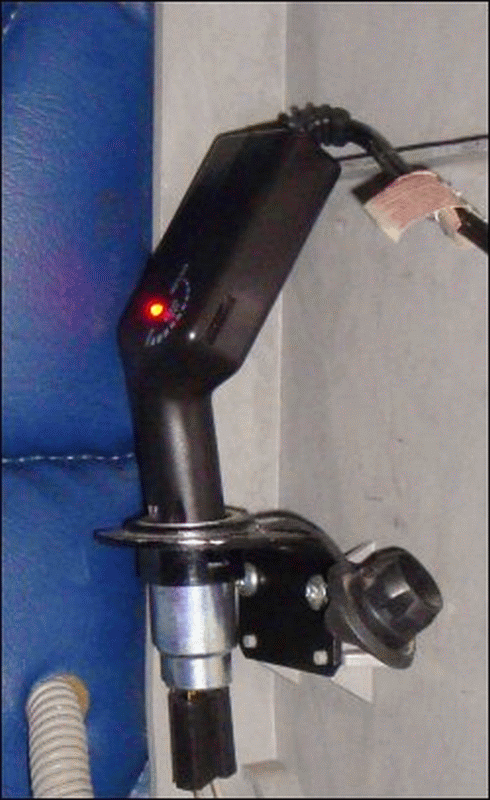 Because it is a 12-volt product, this device could be used only with a 12-volt power source.
Because it is a 12-volt product, this device could be used only with a 12-volt power source.
Compare this with standard 120-volt household appliances — which can be plugged into either a standard electrical outlet or an inverter.
The plug had to be placed firmly in the 12-volt outlet or it could pop out.
In using his product, Mike literally had to brace the plug under part of the built-in cabinetry to keep it from popping out of the outlet.
For this reason, a driver who powers his/her unit from the outlet on the dash may experience difficulties in getting it to stay in place.
Electrical Problems
Mike’s unit caused electrical problems in his truck, about which he elaborates here.
Since
- Mike’s truck’s air conditioning continued having problems;
- it was the time of year when there was warm weather; and
- the Tornado Fan had a clamp to hold it in place,
Mike decided to use it while he was driving.
He did not immediately connect the use of the fan with this situation, but he found that these gauges on his dashboard didn’t work properly:
- oil pressure gauge;
- water temperature gauge;
- volt gauge;
- tachometer; and
- speedometer.
In addition to these, the digital odometer did not record the miles he had traveled.
 Mike was at a loss to know what was wrong!
Mike was at a loss to know what was wrong!
He took his truck to the company shop but to no avail.
The fan was not plugged into the 12-volt outlet when the truck was in the shop, so the circumstances could not be traced to the fan’s operation.
At least when Mike had his truck in the shop that time, the compressor on the air conditioner was replaced, allowing Mike to be able to use the A/C.
A little while later, he was parked at a shipper getting loaded and idled his truck with the air conditioner going.
Before lying down in the sleeper, he plugged in the Tornado Fan for extra air circulation.
After a few minutes, he realized that it was getting warm in the truck.
He got up and also saw that the gauges were acting strangely again, such as he had seen before the compressor was replaced.
Because the air that the Tornado Fan was circulating was just warm air, Mike decided to turn it off and lie down again but allow the truck to keep idling.
After a few minutes, the air conditioner started pumping out cold air again.
He turned on the Tornado Fan again.
Guess what happened a few minutes later?
It got warm again!
That’s when Mike put two and two together.
He turned the fan off and unplugged it all together.
A few minutes later, the air conditioner pumped out cold air.
A third time, Mike deliberately plugged in and turned on the Tornado Fan and closely watched his instrumentation.
They went down.
He turned off the Tornado Fan and watched the instrumentation come back up.
Then he tried it again and the same thing happened.
The Tornado Fan worked well when the truck was not on.
We were parked at a truckstop in Milton, PA, in June when the temperature overnight was pretty mild.
(Note: Pennsylvania now has a no idling law for big trucks.)
Mike turned off the truck, opened the sleeper berth vents and turned on the Tornado Fan.
Though very noisy, it worked well all night.
What Was the Real Problem?
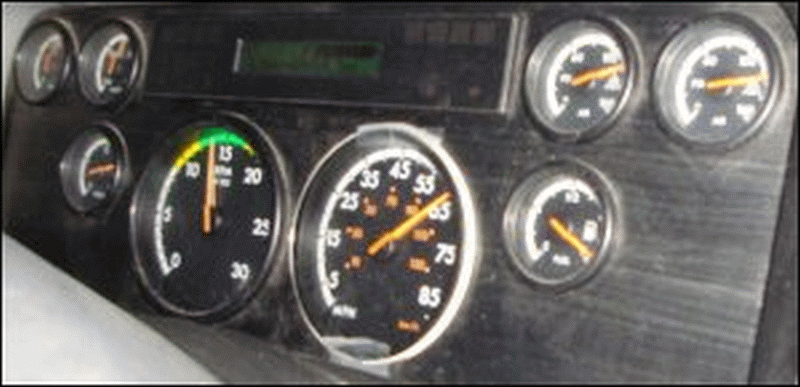 To this day, Mike does not know why the Tornado Fan he bought adversely affected his truck’s instrumentation when the truck was on.
To this day, Mike does not know why the Tornado Fan he bought adversely affected his truck’s instrumentation when the truck was on.
(The photo shown here shows all of the instrumentation working correctly.)
Vicki asked Mike if plugging the fan into the 12-volt outlet on the dash had the same effect and he said that that outlet in that truck did not work, so we couldn’t test it.
Furthermore, as all of Mike’s other appliances are powered via the battery-connected inverter, Mike did not have any other 12-volt appliances to test in that outlet.
It is possible that there was a problem with that truck’s wiring, or that the power drawn by the Tornado Fan caused a short or trip in the electrical system.
However, it is a moot point for us because using the unit when the truck was on caused problems.
Bent Plug Design
Another feature that some drivers may consider to be a “pro” that other drivers may consider to be a “con” is the fact that the plug of this unit was designed with a 45-degree angle.
This feature may make grasping the switch to change the fan speed more convenient.
Conclusion
As is commonly the case with other 12-volt products we’ve reviewed, the performance of the Tornado Fan left a lot to be desired in our opinion.
Mike modified for Vicki the familiar phrase “you get what you pay for” by saying,
“With 12-volt products, you don’t get what you pay for.”
Other drivers (and other users of this 12-volt appliance) may have had a different experience from ours.
However, we recommend that if you want to use a fan in your truck and you have an inverter, just use a standard household fan and skip the RoadPro® Tornado Fan.
![]() Money saving tip: Every consumer must determine for himself or herself if any product or service is worth the cost.
Money saving tip: Every consumer must determine for himself or herself if any product or service is worth the cost.
One measure of the value of a product is the warranty.
Just like the metal fan, the RoadPro® Tornado Fan that Mike bought had only a 90-day limited warranty.
Most household appliances have at least a one-year warranty. Let the buyer beware!
If you are concerned about the cost of the type of inverter that you connect directly to your truck’s batteries, remember that you can buy the type that plugs directly into your cigarette lighter.
From this, you can use appliances that draw no more power than it can provide.
Consider saving yourself the cost of the cheaply made but expensive to buy RoadPro® Tornado Fan and just get a household type fan and inverter.
Return from Review of Tornado Fan: Pros and Cons of 12-Volt RoadPro® Unit to our Product Reviews page or our Truck Drivers Money Saving Tips home page.













